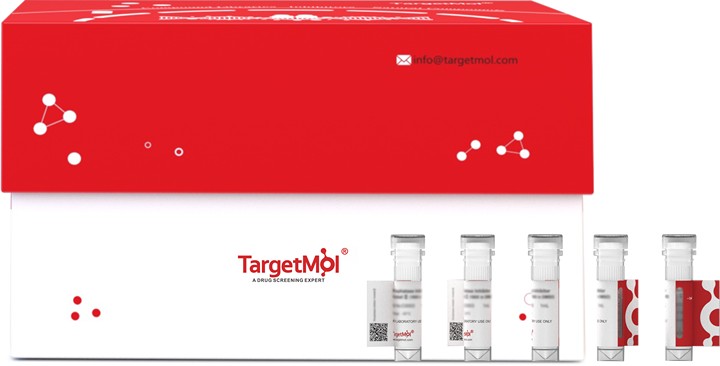 您的购物车当前为空
您的购物车当前为空
AKR1A1 Protein, Human, Recombinant (His)
一键复制产品信息Aldehyde reductase (AKR1A1) is a member of the aldo-keto reductase superfamily, which consists of more than 40 known enzymes and proteins that includes variety of monomeric NADPH-dependent oxidoreductases, such as aldehyde reductase. Aldehyde reductase has wide substrate specificities for carbonyl compounds. These enzymes are implicated in the development of diabetic complications by catalyzing the reduction of glucose to sorbitol. Aldehyde reductase possess a structure with a beta-alpha-beta fold which contains a novel NADP-binding motif. The binding site is located in a large, deep, elliptical pocket in the C-terminal end of the beta sheet, the substrate being bound in an extended conformation. This binding is more similar to FAD- than to NAD(P)-binding oxidoreductases. AKR1A1 is involved in the reduction of biogenic and xenobiotic aldehydes and is present in virtually every tissue.

AKR1A1 Protein, Human, Recombinant (His)
一键复制产品信息| 规格 | 价格 | 库存 | 数量 |
|---|---|---|---|
| 5 μg | ¥ 797 | 6-8日内发货 | |
| 10 μg | ¥ 1,320 | 6-8日内发货 | |
| 20 μg | ¥ 2,180 | 5日内发货 | |
| 50 μg | ¥ 4,380 | 5日内发货 | |
| 100 μg | ¥ 7,450 | 5日内发货 |
产品信息
| 生物活性 | Activity testing is in progress. It is theoretically active, but we cannot guarantee it. If you require protein activity, we recommend choosing the eukaryotic expression version first. |
| 产品描述 | Aldehyde reductase (AKR1A1) is a member of the aldo-keto reductase superfamily, which consists of more than 40 known enzymes and proteins that includes variety of monomeric NADPH-dependent oxidoreductases, such as aldehyde reductase. Aldehyde reductase has wide substrate specificities for carbonyl compounds. These enzymes are implicated in the development of diabetic complications by catalyzing the reduction of glucose to sorbitol. Aldehyde reductase possess a structure with a beta-alpha-beta fold which contains a novel NADP-binding motif. The binding site is located in a large, deep, elliptical pocket in the C-terminal end of the beta sheet, the substrate being bound in an extended conformation. This binding is more similar to FAD- than to NAD(P)-binding oxidoreductases. AKR1A1 is involved in the reduction of biogenic and xenobiotic aldehydes and is present in virtually every tissue. |
| 种属 | Human |
| 表达系统 | E. coli |
| 标签 | N-His |
| 蛋白编号 | P14550 |
| 别名 | HEL-S-6,DD3,ARM,ALR,ALDR1,aldo-keto reductase family 1, member A1 (aldehyde reductase) |
| 蛋白构建 | A DNA sequence encoding the human AKR1A1 (P14550) (Met 1-Tyr 325) was expressed, with a polyhistidine tag at the N-terminus. Predicted N terminal: Met |
| 蛋白纯度 | > 90 % as determined by SDS-PAGE |
| 分子量 | 39 kDa (predicted); 39 kDa (reducing conditions) |
| 内毒素 | Please contact us for more information. |
| 蛋白性状 | Lyophilized powder |
| 缓冲液 | Lyophilized from a solution filtered through a 0.22 μm filter, containing PBS, pH 7.5. Typically, a mixture containing 5% to 8% trehalose, mannitol, and 0.01% Tween 80 is incorporated as a protective agent before lyophilization. |
| 复溶方法 | A Certificate of Analysis (CoA) containing reconstitution instructions is included with the products. Please refer to the CoA for detailed information. |
| 存储 | It is recommended to store recombinant proteins at -20°C to -80°C for future use. Lyophilized powders can be stably stored for over 12 months, while liquid products can be stored for 6-12 months at -80°C. For reconstituted protein solutions, the solution can be stored at -20°C to -80°C for at least 3 months. Please avoid multiple freeze-thaw cycles and store products in aliquots. |
| 运输方式 | In general, Lyophilized powders are shipping with blue ice. |
| 研究背景 | Aldehyde reductase (AKR1A1) is a member of the aldo-keto reductase superfamily, which consists of more than 40 known enzymes and proteins that includes variety of monomeric NADPH-dependent oxidoreductases, such as aldehyde reductase. Aldehyde reductase has wide substrate specificities for carbonyl compounds. These enzymes are implicated in the development of diabetic complications by catalyzing the reduction of glucose to sorbitol. Aldehyde reductase possess a structure with a beta-alpha-beta fold which contains a novel NADP-binding motif. The binding site is located in a large, deep, elliptical pocket in the C-terminal end of the beta sheet, the substrate being bound in an extended conformation. This binding is more similar to FAD- than to NAD(P)-binding oxidoreductases. AKR1A1 is involved in the reduction of biogenic and xenobiotic aldehydes and is present in virtually every tissue. |





 |
|